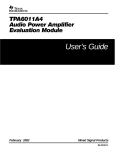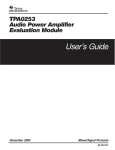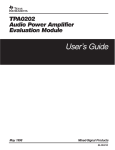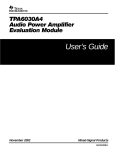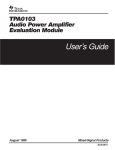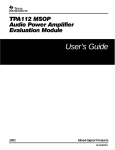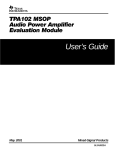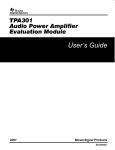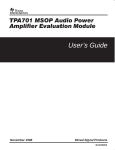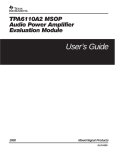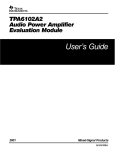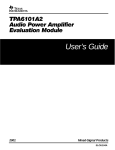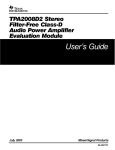Download Texas Instruments TPA0242 User's Manual
Transcript
TPA0242 Audio Power Amplifier Evaluation Module User’s Guide March 2000 Mixed-Signal Products SLOU074 IMPORTANT NOTICE Texas Instruments and its subsidiaries (TI) reserve the right to make changes to their products or to discontinue any product or service without notice, and advise customers to obtain the latest version of relevant information to verify, before placing orders, that information being relied on is current and complete. All products are sold subject to the terms and conditions of sale supplied at the time of order acknowledgement, including those pertaining to warranty, patent infringement, and limitation of liability. TI warrants performance of its semiconductor products to the specifications applicable at the time of sale in accordance with TI’s standard warranty. Testing and other quality control techniques are utilized to the extent TI deems necessary to support this warranty. Specific testing of all parameters of each device is not necessarily performed, except those mandated by government requirements. CERTAIN APPLICATIONS USING SEMICONDUCTOR PRODUCTS MAY INVOLVE POTENTIAL RISKS OF DEATH, PERSONAL INJURY, OR SEVERE PROPERTY OR ENVIRONMENTAL DAMAGE (“CRITICAL APPLICATIONS”). TI SEMICONDUCTOR PRODUCTS ARE NOT DESIGNED, AUTHORIZED, OR WARRANTED TO BE SUITABLE FOR USE IN LIFE-SUPPORT DEVICES OR SYSTEMS OR OTHER CRITICAL APPLICATIONS. INCLUSION OF TI PRODUCTS IN SUCH APPLICATIONS IS UNDERSTOOD TO BE FULLY AT THE CUSTOMER’S RISK. In order to minimize risks associated with the customer’s applications, adequate design and operating safeguards must be provided by the customer to minimize inherent or procedural hazards. TI assumes no liability for applications assistance or customer product design. TI does not warrant or represent that any license, either express or implied, is granted under any patent right, copyright, mask work right, or other intellectual property right of TI covering or relating to any combination, machine, or process in which such semiconductor products or services might be or are used. TI’s publication of information regarding any third party’s products or services does not constitute TI’s approval, warranty or endorsement thereof. Copyright 2000, Texas Instruments Incorporated Preface Related Documentation From Texas Instruments J J TI Plug-N-Play Audio Amplifier Evaluation Platform (literature number SLOU011) provides detailed information on the evaluation platform and its use with TI audio evaluation modules. TPA0242 Stereo 2-W Audio Power Amplifier (literature number SLOS287) This is the data sheet for the TPA0242 audio amplifier integrated circuit. FCC Warning This equipment is intended for use in a laboratory test environment only. It generates, uses, and can radiate radio frequency energy and has not been tested for compliance with the limits of computing devices pursuant to subpart J of part 15 of FCC rules, which are designed to provide reasonable protection against radio frequency interference. Operation of this equipment in other environments may cause interference with radio communications, in which case the user at his own expense will be required to take whatever measures may be required to correct this interference. Trademarks TI is a trademark of Texas Instruments Incorporated. Chapter Title—Attribute Reference iii iv Running Title—Attribute Reference Contents 1 Introduction . . . . . . . . . . . . . . . . . . . . . . . . . . . . . . . . . . . . . . . . . . . . . . . . . . . . . . . . . . . . . . . . . . . . . 1.1 Feature Highlights . . . . . . . . . . . . . . . . . . . . . . . . . . . . . . . . . . . . . . . . . . . . . . . . . . . . . . . . . . 1.2 Description . . . . . . . . . . . . . . . . . . . . . . . . . . . . . . . . . . . . . . . . . . . . . . . . . . . . . . . . . . . . . . . . 1.3 TPA0242 EVM Specifications . . . . . . . . . . . . . . . . . . . . . . . . . . . . . . . . . . . . . . . . . . . . . . . . 1-1 1-2 1-3 1-3 2 Quick Start . . . . . . . . . . . . . . . . . . . . . . . . . . . . . . . . . . . . . . . . . . . . . . . . . . . . . . . . . . . . . . . . . . . . . . 2.1 Precautions . . . . . . . . . . . . . . . . . . . . . . . . . . . . . . . . . . . . . . . . . . . . . . . . . . . . . . . . . . . . . . . . 2.2 Quick Start List for Platform . . . . . . . . . . . . . . . . . . . . . . . . . . . . . . . . . . . . . . . . . . . . . . . . . . 2.3 Quick Start List for Stand-Alone . . . . . . . . . . . . . . . . . . . . . . . . . . . . . . . . . . . . . . . . . . . . . . 2-1 2-2 2-3 2-5 3 Details . . . . . . . . . . . . . . . . . . . . . . . . . . . . . . . . . . . . . . . . . . . . . . . . . . . . . . . . . . . . . . . . . . . . . . . . . . 3-1 3.1 Precautions . . . . . . . . . . . . . . . . . . . . . . . . . . . . . . . . . . . . . . . . . . . . . . . . . . . . . . . . . . . . . . . . 3-2 3.2 The TPA0242 Audio Power Amplifier Evaluation Module . . . . . . . . . . . . . . . . . . . . . . . . . 3-3 3.2.1 TPA0242 Audio Amplifier IC . . . . . . . . . . . . . . . . . . . . . . . . . . . . . . . . . . . . . . . . . . 3-4 3.2.2 Inputs and Gain . . . . . . . . . . . . . . . . . . . . . . . . . . . . . . . . . . . . . . . . . . . . . . . . . . . . . 3-5 3.2.3 Differential Input . . . . . . . . . . . . . . . . . . . . . . . . . . . . . . . . . . . . . . . . . . . . . . . . . . . . . 3-6 3.2.4 Depop Circuitry . . . . . . . . . . . . . . . . . . . . . . . . . . . . . . . . . . . . . . . . . . . . . . . . . . . . . 3-7 3.2.5 BTL Operation . . . . . . . . . . . . . . . . . . . . . . . . . . . . . . . . . . . . . . . . . . . . . . . . . . . . . . 3-7 3.2.6 Single-Ended Operation . . . . . . . . . . . . . . . . . . . . . . . . . . . . . . . . . . . . . . . . . . . . . . 3-7 3.3 Using The TPA0242 EVM With the Plug-N-Play Evaluation Platform . . . . . . . . . . . . . . . 3-8 3.3.1 Installing and Removing EVM Boards . . . . . . . . . . . . . . . . . . . . . . . . . . . . . . . . . . 3-8 3.3.2 TPA0242 Module Jumper Settings and Switches . . . . . . . . . . . . . . . . . . . . . . . . 3-9 3.3.3 Signal Routing . . . . . . . . . . . . . . . . . . . . . . . . . . . . . . . . . . . . . . . . . . . . . . . . . . . . . 3-11 3.3.4 Mute (Shutdown)/Mode . . . . . . . . . . . . . . . . . . . . . . . . . . . . . . . . . . . . . . . . . . . . . 3-12 3.3.5 Power Requirements . . . . . . . . . . . . . . . . . . . . . . . . . . . . . . . . . . . . . . . . . . . . . . . . 3-14 3.3.6 Inputs and Outputs . . . . . . . . . . . . . . . . . . . . . . . . . . . . . . . . . . . . . . . . . . . . . . . . . 3-15 3.4 Using The TPA0242 EVM Stand-Alone . . . . . . . . . . . . . . . . . . . . . . . . . . . . . . . . . . . . . . . 3-16 3.4.1 TPA0242 EVM Connected for BTL Output . . . . . . . . . . . . . . . . . . . . . . . . . . . . . 3-16 3.4.2 TPA0242 EVM Connected for Single-Ended Output . . . . . . . . . . . . . . . . . . . . . 3-17 3.5 TPA0242 Audio Power Amplifier Evaluation Module Parts List . . . . . . . . . . . . . . . . . . . 3-18 Chapter Title—Attribute Reference v Running Title—Attribute Reference Figures 1–1 2–1 2–2 2–3 3–1 3–2 3–3 3–4 3–5 3–6 3–7 3–8 3–9 3–10 The TI TPA0242 Audio Amplifier Evaluation Module . . . . . . . . . . . . . . . . . . . . . . . . . . . . . . . 1-3 Quick Start Platform Map . . . . . . . . . . . . . . . . . . . . . . . . . . . . . . . . . . . . . . . . . . . . . . . . . . . . . . 2-2 Module Preparation . . . . . . . . . . . . . . . . . . . . . . . . . . . . . . . . . . . . . . . . . . . . . . . . . . . . . . . . . . . 2-4 Quick Start Module Map . . . . . . . . . . . . . . . . . . . . . . . . . . . . . . . . . . . . . . . . . . . . . . . . . . . . . . . 2-5 The TI Plug-N-Play Audio Amplifier Evaluation Platform . . . . . . . . . . . . . . . . . . . . . . . . . . . . 3-2 TPA0242 EVM . . . . . . . . . . . . . . . . . . . . . . . . . . . . . . . . . . . . . . . . . . . . . . . . . . . . . . . . . . . . . . . . 3-3 TPA0242 EVM Schematic Diagram . . . . . . . . . . . . . . . . . . . . . . . . . . . . . . . . . . . . . . . . . . . . . . 3-4 TPA0242 Amplifier IC . . . . . . . . . . . . . . . . . . . . . . . . . . . . . . . . . . . . . . . . . . . . . . . . . . . . . . . . . . 3-5 TPA0242 EVM Jumpers and Switches . . . . . . . . . . . . . . . . . . . . . . . . . . . . . . . . . . . . . . . . . . . 3-9 Platform Signal Routing and Outputs . . . . . . . . . . . . . . . . . . . . . . . . . . . . . . . . . . . . . . . . . . . 3-11 Mute/Mode and Polarity Control . . . . . . . . . . . . . . . . . . . . . . . . . . . . . . . . . . . . . . . . . . . . . . . . 3-12 Typical Headphone Plug . . . . . . . . . . . . . . . . . . . . . . . . . . . . . . . . . . . . . . . . . . . . . . . . . . . . . . 3-15 TPA0242 EVM Connected for Stereo BTL Output . . . . . . . . . . . . . . . . . . . . . . . . . . . . . . . . 3-16 TPA0242 EVM Connected for Stereo Single-Ended Output . . . . . . . . . . . . . . . . . . . . . . . . 3-17 Tables 2–1 2–2 2–3 2–4 3–1 3–2 3–3 3–4 vi Typical TI Plug-N-Play Platform Jumper and Switch Settings for the TPA0242 . . . . . . . . . 2-1 Typical TPA0242 EVM Jumper Settings . . . . . . . . . . . . . . . . . . . . . . . . . . . . . . . . . . . . . . . . . . 2-1 Platform Jumper and Switch Settings for the TPA0242 . . . . . . . . . . . . . . . . . . . . . . . . . . . . . 2-3 Typical TPA0242 EVM Jumper Settings . . . . . . . . . . . . . . . . . . . . . . . . . . . . . . . . . . . . . . . . . . 2-4 TPA0242 EVM BTL Volume Settings . . . . . . . . . . . . . . . . . . . . . . . . . . . . . . . . . . . . . . . . . . . . 3-6 Typical TPA0242 EVM Jumper Settings for BTL Stand-Alone . . . . . . . . . . . . . . . . . . . . . . 3-16 Typical TPA0242 EVM Jumper Settings for Single-Ended Stand-Alone . . . . . . . . . . . . . . 3-17 TPA0242 EVM Parts List . . . . . . . . . . . . . . . . . . . . . . . . . . . . . . . . . . . . . . . . . . . . . . . . . . . . . . 3-18 Chapter 1 Introduction This chapter provides an overview of the Texas Instruments (TI) TPA0242 audio amplifier evaluation module (SLOP275). It includes a list of EVM features, a brief description of the module illustrated with a pictorial diagram, and a list of EVM specifications. Topic Page 1.1 Feature Highlights . . . . . . . . . . . . . . . . . . . . . . . . . . . . . . . . . . . . . . . . . . . . 1–2 1.2 Description . . . . . . . . . . . . . . . . . . . . . . . . . . . . . . . . . . . . . . . . . . . . . . . . . . . 1–3 1.3 TPA0242 EVM Specifications . . . . . . . . . . . . . . . . . . . . . . . . . . . . . . . . . . . 1–3 Introduction 1-1 Feature Highlights 1.1 Feature Highlights The TI TPA0242 audio amplifier evaluation module and the TI plug-n-play audio amplifier evaluation platform include the following features: - - TPA0242 stereo 2-W audio power amplifier evaluation module J J J J J J J J J J J J - 1-2 Dual channel, bridge-tied load (BTL) or single-ended operation 2 W per channel output power into 3 Ω at 5 V, BTL Low current consumption in shutdown mode (150 µA) Internal input MUX selects among two sets of stereo inputs DC voltage volume control from +20 dB to –40 dB, and a –85 dB mute Differential stereo inputs PC Beep input Quick and easy configuration with the TI plug-n-play audio amplifier evaluation platform J - Internal depop circuitry to minimize transients in outputs Evaluation module is designed to simply plug into the platform, automatically making all signal, control, and power connections Platform provides flexible power options Jumpers on the platform select power and module control options Switches on the platform route signals Platform provides quick and easy audio input and output connections Platform power options J J J J External 5-V – 15-V DC VCC supply inputs External regulated VDD supply input Socket for on-board 5 V/3.3 V VDD voltage regulator EVM Onboard overvoltage and reverse polarity power protection Platform audio input and output connections J J J J J Left and right RCA phono jack inputs Miniature stereo phone jack input Left and right RCA phono jack outputs Left and right compression speaker terminal outputs Miniature stereo headphone jack output Introduction Description 1.2 Description The TPA0242 stereo 2-W audio power amplifier evaluation module is a complete, 2-watt per channel stereo audio power amplifier. It consists of the TI TPA0242 stereo 2-W audio power amplifier IC along with a small number of other parts mounted on a circuit board that measures approximately 2 1/4 inches by 1 1/2 inches (Figure 1–1). Figure 1–1. The TI TPA0242 Audio Amplifier Evaluation Module VDD R HP GND + GND GND ROUT– S4 S3 S2 R4 R3 C6 C5 C4 C3 R LINE– SHUTDOWN R IN+ ROUT+ C10 HP/LINE SE/BTL S1 C11 R1 PCBEEP C1 U1 C2 C12 L IN+ R2 SHUTDOWN C9 C8 C7 L LINE– TEXAS INSTRUMENTS LOUT– GND + L HP TPA00242 EVM Board VDD GND C13 GND SLOP275 LOUT+ Single in-line header pins extend from the underside of the module circuit board to allow the EVM to be plugged into the TI plug-n-play audio amplifier evaluation platform, or to be wired directly into existing circuits and equipment when used stand-alone. The platform has room for a single TPA0242 evaluation module and is a convenient vehicle for demonstrating TI’s audio power amplifier and related evaluation modules. The EVMs simply plug into the platform, which automatically provides power to the modules, interconnects them correctly, and connects them to a versatile array of standard audio input and output jacks and connectors. Easy-to-use configuration controls allow the platform and EVMs to quickly model many possible end-equipment configurations. There is nothing to build, nothing to solder, and nothing but the speakers included with the platform to hook up. 1.3 TPA0242 EVM Specifications Supply voltage range, VDD . . . . . . . . . . . . . . . . . . . . . . . . . . . . . . 4.5 V to 5.5 V Supply current, IDD . . . . . . . . . . . . . . . . . . . . . . . . . . . . . . . . . . . . . . . . . 2 A max Continuous output power per channel, PO: 3-Ω BTL, VDD = 5 V . . . . . . 2 W Audio input voltage, VI,: HP input . . . . . . . . . . . . . . . . . . . . . . . . . . 5 Vpp max Line input . . . . . . . . . . . . . . . . . . . . . . . . 5 Vpp max PC BEEP input . . . . . . . . . . . . . . . . . . . . 5 Vpp max Minimum load impedance, RL . . . . . . . . . . . . . . . . . . . . . . . . . . . . . . . . . . . . 3 Ω Introduction 1-3 1-4 Introduction Chapter 2 Quick Start The steps in this chapter can be followed to quickly prepare the TPA0242 audio amplifier EVM for use. Using the TPA0242 with the TI plug-n-play audio amplifier evaluation platform is a quick and easy way to connect power, signal and control inputs, and signal outputs to the EVM using standard connectors. However, the audio amplifier evaluation module can be used stand-alone by making connections directly to the module pins, and can be wired directly into existing circuits or equipment. The platform switch and jumper settings shown in Table 2–1 are typical for the TPA0242 EVM and will cause the TPA0242 to switch to single-ended output mode when a plug is inserted into platform headphone jack J10. Table 2–1. Typical TI Plug-N-Play Platform Jumper and Switch Settings for the TPA0242 EVM JP6 JP7 JP8 S2 S3 P-N-P Platform Mode X Hi Note 2 U2–U4 Notes: 1) X = Don’t care 2) Set S2 to ON when signal conditioning board is installed in U1; set S2 to OFF when no signal conditioning board is installed. Table 2–2. Typical TPA0242 EVM Jumper Settings Note: EVM S3 TPA0242 OFF ON = Shunt installed OFF = Open Topic Page 2.1 Precautions . . . . . . . . . . . . . . . . . . . . . . . . . . . . . . . . . . . . . . . . . . . . . . . . . . 2–2 2.2 Quick Start List for Platform . . . . . . . . . . . . . . . . . . . . . . . . . . . . . . . . . . . 2–3 2.3 Quick Start List for Stand-Alone . . . . . . . . . . . . . . . . . . . . . . . . . . . . . . . . 2–5 Quick Start 2-1 Precautions 2.1 Precautions Power Supply Input Polarity and Maximum Voltage Always ensure that the polarity and voltage of the external power connected to VCC power input connector J1, J2, and/or VDD power input connector J6 are correct. Overvoltage or reverse-polarity power applied to these terminals can open onboard soldered-in fuses and cause other damage to the platform, installed evaluation modules, and/or the power source. Inserting or Removing EVM Boards Do not insert or remove EVM boards with power applied—damage to the EVM board, the platform, or both may result. Figure 2–1. Quick Start Platform Map 7b 1 13 C1+ On Off ICC 7 b VR2 JP4 VR1 + J6 Left Out Stereo Headphone Output J10 + HP Out R4 6 5 J9 + S3 HP Source Spk(U2-U4) C3 C2 JP8 U5 JP7 HP(U5) U2-U4 R3 + JP6 U4 U5 GND 2 TP1 Plug-N-Play Audio Amplifier Evaluation Platform SLOP097 Rev. C.1 10 Speaker Output – Left Out On Conditioning TEXAS INSTRUMENTS 1997 2-2 VDD In/Out U2 U1 J5 Left In Mode Mute Polarity Lo Hi ****CAUTION**** Do not insert or remove EVM boards with power applied 3 + Right – Out U3 Off S2 J4 Stereo In Audio Input DC Power In/Out J8 J7 Right Out LED2 VDD Audio Power Amps Signal Conditioning 9 R2 JP5 IDD LED1 VCC J3 Right In R1 7a F2 B1 D1 D2 D3 D4 J2 AC/DC In Power Input U6 7b POWER SUPPLY S1 Pwr J1 VCC In + JP3 Batt JP2 AC/DC JP1 (J2) VCC(J1) DC SOURCE F1 7 b R5 4 Quick Start Quick Start List for Platform 2.2 Quick Start List for Platform Follow these steps when using the TPA0242 EVM with the TI plug-n-play audio amplifier evaluation platform (see the platform user’s guide, SLOU011, for additional details). Numbered callouts for selected steps are shown in Figure 2–1 and Figure 2–2, and details appear in Chapter 3. - Platform preparations 1) Ensure that all external power sources are set to OFF and that the platform power switch S1 is set to OFF. 2) Install a TPA0242 module in platform socket U2, taking care to align the module pins correctly. 3) Use switch S2 to select or bypass the signal conditioning EVM (U1). 4) Set control signal Polarity jumper JP8 to Hi. 5) Set jumper JP6 to select the Mode control input (causes the TPA0242 to switch to the single-ended output mode if a plug is inserted into platform headphone jack J10). 6) If the headphone jack (J10) output will be used, set headphone source switch S3 to U2–U4. Table 2–3. Platform Jumper and Switch Settings for the TPA0242 EVM JP6 JP7 JP8 S2 S3 P-N-P Platform Mode X Hi Note 2 U2–U4 Notes: - 1) X = Don’t care 2) Set S2 to ON when signal conditioning board is installed in U1; set S2 to OFF when no signal conditioning board is installed. Power supply 7) Select and connect the power supply (ensure power supply is set to OFF ): a) Connect an external regulated power supply set to 5 V to platform VDD power input connector J6 taking care to observe marked polarity, or b) Install a voltage regulator EVM (SLVP097 or equiv.) in platform socket U6. Connect a 7 V – 12 V power source to a platform VCC power input J1 or J2 and jumper the appropriate power input (see platform user’s guide). - Inputs and outputs 8) Ensure that the audio signal source level is set to minimum. 9) Connect the audio source to left and right RCA phono jacks J3 and J5 or stereo miniature phone jack J4. 10) Connect speakers to left and right RCA jacks J7 and J9 or to stripped wire speaker connectors J8. Quick Start 2-3 Quick Start List for Platform - Evaluation module preparations Figure 2–2. Module Preparation VDD R HP GND + GND GND ROUT– S4 S3 S2 R4 R3 C6 C5 C4 C3 R LINE– SHUTDOWN R IN+ ROUT+ C10 HP/LINE SE/BTL S1 C11 R1 13 PCBEEP C1 C12 14 L IN+ 12 U1 C2 R2 TEXAS INSTRUMENTS 11 SHUTDOWN C9 C8 C7 L LINE– LOUT– GND + L HP VDD TPA00242 EVM Board GND C13 GND SLOP275 LOUT+ Table 2–4. Typical TPA0242 EVM Jumper Settings Note: EVM S3 TPA0242 OFF ON = Shunt installed, OFF = Open 11) To allow the module SE/BTL control input to switch the amplifier IC between single ended (SE) and bridge-tied load (BTL) output modes, set output mode jumper S3 to OFF. To keep the module amplifier IC in the single-ended output mode regardless of the control input state, set jumper S3 to ON. 12) To allow the module HP/LINE control input to switch the amplifier IC between using the HP pins and the LINE pins as the signal inputs, set the input mode jumper S3 to OFF. To keep the amplifier IC in the HP input mode regardless of the control input state, set jumper S3 to ON. - Power Up 13) To allow the amplifier IC to switch from the LINE inputs to the HP inputs when the output switches from BTL output mode to SE output mode and vice versa, set jumper S4 to ON. To allow the inputs and output modes to switch independently, set jumper S4 to OFF. Platform LED2 should light indicating the presence of VDD, and the evaluation modules installed on the platform should begin operation. 14) Adjust the signal source level as needed. 2-4 Quick Start Quick Start List for Stand-Alone 2.3 Quick Start List for Stand-Alone Follow these steps to use the TPA0242 EVM stand-alone or when connecting it into existing circuits or equipment. Connections to the TPA0242 module header pins can be made via individual sockets, wire-wrapping, or soldering to the pins, either on the top or the bottom of the module circuit board. Numbered callouts for selected steps are shown in Figure 2–3 and details appear in Chapter 3. Figure 2–3. Quick Start Module Map VDD R HP GND + GND GND ROUT– S4 S3 S2 R4 R3 C6 C5 C4 C3 R LINE– SHUTDOWN R IN+ ROUT+ C10 HP/LINE SE/BTL S1 C11 R1 PCBEEP C1 C12 9 L IN+ R2 TEXAS INSTRUMENTS LOUT– GND + L HP TPA00242 EVM Board - 6 SHUTDOWN C9 C8 C7 L LINE– 7 U1 C2 8 VDD GND C13 GND SLOP275 LOUT+ Power supply 1) Ensure that all external power sources are set to OFF. 2) Connect an external regulated power supply set to 5 V to the module VDD and GND pins taking care to observe marked polarity. - Inputs and outputs 3) Ensure that audio signal source level adjustments are set to minimum. 4) Connect the right (left) positive lead of the audio source to the module R LINE– (L LINE–) pins and the negative lead to the R IN+ (L IN+) pins. If using the headphone inputs, connect the positive audio source to the module R HP (L HP) and the negative lead to R IN+ (L IN+). The inputs can be used with a differential or single-ended audio source, but the headphone and line have common positive inputs. 5) Select output mode: a) For BTL output, connect a speaker to the module OUT+ and OUT– pins of each channel, or b) For single-ended output, connect a headphone or a speaker to the module OUT+ and GND pins of each channel through a 33 µF to 1000 µF output-coupling capacitor (Figure 3–10). Quick Start 2-5 Quick Start List for Stand-Alone - Evaluation module preparations 6) To allow the module SE/BTL control input to switch the amplifier IC between single ended (SE) and bridge-tied load (BTL) output modes, set output mode jumper S3 to OFF. To keep the module amplifier IC in the single-ended output mode regardless of the control input state, set jumper S3 to ON. 7) To allow the module HP/LINE control input to switch the amplifier IC between using the HP pins and the LINE pins as the signal inputs, set the input mode jumper S3 to OFF. To keep the amplifier IC in the HP input mode regardless of the control input state, set jumper S3 to ON. - Control inputs 8) To allow the amplifier IC to switch from the LINE inputs to the HP inputs when the output switches from BTL output mode to SE output mode and vice versa, set jumper S4 to ON. To allow the inputs and output modes to switch independently, set jumper S4 to OFF. Connect control lines to the various module control input pins as needed: a) SE/BTL: A high selects the single-ended (SE) output mode; a low or float selects the bridge-tied load (BTL) output mode. - b) SHUTDOWN: A low shuts down the amplifier IC on the module; a high or float allows normal operation. Power-up 9) Verify correct voltage and input polarity and set the external power supply to ON. The EVM should begin operation. 10) Adjust the signal source level as needed. 2-6 Quick Start Chapter 3 Details This chapter provides details on the TPA0242 IC, the evaluation module, and the steps in the Quick-Start List, additional application information, and a parts list for the TPA0242 evaluation module. Topic Page 3.1 Precautions . . . . . . . . . . . . . . . . . . . . . . . . . . . . . . . . . . . . . . . . . . . . . . . . . . 3–2 3.2 The TPA0242 Audio Power Amplifier Evaluation Module . . . . . . . . . 3–3 3.3 Using the TPA0242 EVM With the Plug-N-Play Evaluation Platform . . . . . . . . . . . . . . . . . . . . . . . . . . . . . . . . . . . . . . . . . . . 3–8 3.4 Using The TPA0242 EVM Stand-Alone . . . . . . . . . . . . . . . . . . . . . . . . 3–16 3.5 TPA0242 Audio Power Amplifier Evaluation Module Parts List . . 3–18 Details 3-1 Precautions 3.1 Precautions Power Supply Input Polarity and Maximum Voltage Always ensure that the polarity and voltage of the external power connected to VCC power input connector J1, J2, and/or VDD power input connector J6 are correct. Overvoltage or reverse-polarity power applied to these terminals can open onboard soldered-in fuses and cause other damage to the platform, installed evaluation modules, and/or the power source. Inserting or Removing EVM Boards Do not insert or remove EVM boards with power applied—damage to the EVM board, the platform, or both may result. Figure 3–1. The TI Plug-N-Play Audio Amplifier Evaluation Platform C1+ On Off ICC VR2 JP4 VR1 F2 + J6 VDD In/Out + Right – Out U3 Off S2 J4 Stereo In U2 U1 Speaker Output – Left Out On Conditioning J5 Left In JP6 J9 Left Out + Stereo Headphone Output HP Out J10 + S3 HP Source Spk(U2-U4) C3 C2 JP8 U5 JP7 HP(U5) U2-U4 R3 R4 + Mode Mute Polarity Lo Hi U4 U5 GND TP1 TEXAS INSTRUMENTS 1997 Plug-N-Play Audio Amplifier Evaluation Platform SLOP097 Rev. C.1 DC Power In/Out J8 J7 Right Out LED2 VDD Audio Power Amps ****CAUTION**** Do not insert or remove EVM boards with power applied 3-2 U6 R2 JP5 IDD LED1 VCC J3 Right In R1 Signal Conditioning Audio Input POWER D1 D2 D3 D4 J2 AC/DC In B1 SUPPLY S1 Pwr J1 JP3 Batt JP2 AC/DC JP1 (J2) VCC(J1) DC SOURCE VCC In + Power Input F1 R5 Details The TPA0242 Audio Power Amplifier Evaluation Module 3.2 The TPA0242 Audio Power Amplifier Evaluation Module The TPA0242 audio power amplifier evaluation module is powered by a TPA0242 stereo power amplifier capable of delivering greater than 2 W of continuous power per channel into 3-Ω loads. The amplifier IC can be operated in either the BTL or single-ended output mode. The evaluation module includes control inputs for shutdown, selection between two sets of stereo inputs, and switching between single-ended and bridge-tied load output modes. The module can be used with the TI plug-n-play audio amplifier evaluation platform (Figure 3 –1) or wired directly into circuits or equipment. The module has single in-line header connector pins mounted to the under side of the board. These pins allow the module to be plugged into the TI platform, which automatically makes all the signal input and output, power, and control connections to the module. The module connection pins are on 0.1-inch centers to allow easy use with standard perf board and plug board-based prototyping systems. Or, the EVM can be wired directly into existing circuits and equipment when used standalone. The module appears in Figure 3–2 and its schematic is shown in Figure 3 – 3. Figure 3–2. TPA0242 EVM VDD R HP GND + GND GND ROUT– S4 S3 S2 R4 R3 C6 C5 C4 C3 R LINE– SHUTDOWN R IN+ ROUT+ C10 HP/LINE SE/BTL S1 C11 R1 PCBEEP C1 U1 C2 C12 L IN+ R2 SHUTDOWN C9 C8 C7 L LINE– TEXAS INSTRUMENTS LOUT– GND + L HP TPA00242 EVM Board VDD GND C13 GND SLOP275 Details LOUT+ 3-3 The TPA0242 Audio Power Amplifier Evaluation Module Figure 3–3. TPA0242 EVM Schematic Diagram R2 50 kΩ 1 VDD CW 2 TP1 CCW 3 4 S4 L OUT + R1 100 kΩ PCB ENABLE RLINEIN VOLUME LOUT+ SHUTDOWN ROUT+ 5 C7 0.47 µF L HP 6 C8 0.47 µF VDD C12 10 µF 7 8 GND 9 C2 0.47 µF 10 R IN + 11 L OUT – C12 0.47 µF L IN + C9 0.47 µF 12 LLINEIN RHPIN LHPIN VDD PVDD PVDD RIN CLK LOUT– ROUT– LIN SE/BTL BYPASS GND PC–BEEP GND C1 0.47 µF R LINE – VDD 23 SHUTDOWN S1 22 SHUTDOWN 21 20 19 C4 0.47 µF 18 17 16 R OUT + C3 0.47 µF SE/BTL L LINE – 3.2.1 GND TPA0242 S3 HP/LINE GND 24 R3 0Ω VDD C6 47 nF R HP C5 0.1 µF C10 10 µF GND 15 14 13 ROUT– SE/BTL PCBEEP C11 0.47 µF R4 100 kΩ S2 VDD TPA0242 Audio Amplifier IC The TPA0242 audio amplifier IC (Figure 3–4) is a CMOS device intended primarily for bridge-tied load (BTL) operation in battery-powered applications. It is supplied in a very small 24-pin TSSOP thermal surface-mount package and has been designed to operate from low supply voltages (between approximately 4.5 V and 5.5 V). Typical applications include portable computers and multimedia systems. The IC includes two separate amplifier channels, each of which can operate in either the bridged-tied load (BTL) mode or the single-ended mode as selected by the SE/BTL pin. In the BTL mode, the line inputs are automatically selected and the two output lines of each channel operate as mirror images of each other for increased power. The speaker load is connected directly across OUT+ and OUT–, and neither line is connected to ground. BTL operation provides many benefits, including quadruple the output power of single-ended operation and no need for bulky output coupling capacitors. In the single-ended mode, the headphone inputs are automatically selected and the speaker load is connected between the OUT+ terminal, through an output coupling capacitor, to system ground. For more information, see the TPA0242 amplifier IC data sheet, TI literature number SLOS287. 3-4 Details The TPA0242 Audio Power Amplifier Evaluation Module Figure 3–4. TPA0242 Amplifier IC L HP MUX L IN L LINE PC BEEP PC BEEP VOLUME CONTROL VOLUME R LINE R IN MUX R HP HP/LINE 3.2.2 SE/BTL Inputs and Gain Each channel has two separate signal inputs, line and headphone (HP ), that are automatically selected with the output mode (SE/BTL). An input multiplexor in the amplifier IC selects the HP inputs when the IC is in the SE output mode and the line inputs when in the BTL output mode. Line and headphone inputs share common positive inputs. If using separate line and headphone inputs, R IN and L IN should be AC grounded through a capacitor. If using differential inputs, line and headphone inputs must be the same. A third input, PC BEEP, is common to both channels. The TPA0242 IC monitors this input when operating in both the active and shutdown modes and automatically switches to this input when a signal is sensed. In computer applications, for example, this allows the normal audio signal (music, sounds, etc.) to be interrupted when there is a need to output a computer beep. When the beep signal ends, the IC switches back to the previous mode. The PC BEEP input gain is approximately 1/4 V/V, and requires an input signal greater than 1 V peak-to-peak in order to detect the signal. Setting PCB ENABLE high forces the TPA0242 IC into the PC BEEP mode, regardless of the amplitude of the signal applied to the PC BEEP input. Details 3-5 The TPA0242 Audio Power Amplifier Evaluation Module Potentiometer R2 adjusts the gain of the internal preamp stage of the TPA0242 amplifier by adjusting the control voltage applied to the VOLUME terminal (pin 3) of the IC. Rotating the potentiometer slider clockwise decreases the applied control voltage, resulting in a higher volume. Table 3–1 shows the relationship between the control voltage applied to the VOLUME terminal and the effective amplifier gain. Headphone gain is reduced by 6 dB. Table 3–1. TPA0242 EVM BTL Volume Settings VOLUME (Pin 3) FROM (V) TO (V) BTL GAIN (dB) VOLUME (Pin 3) FROM (V) TO (V) BTL GAIN (dB) VOLUME (Pin 3) FROM (V) TO (V) BTL GAIN (dB) 0 0.15 20 1.28 1.39 –2 2.52 2.63 –24 0.15 0.28 18 1.39 1.5 –4 2.63 2.74 –26 0.28 0.39 16 1.5 1.62 –6 2.74 2.86 –28 0.39 0.5 14 1.62 1.73 –8 2.86 2.97 –30 0.5 0.61 12 1.73 1.84 –10 2.97 3.08 –32 0.61 0.73 10 1.84 1.95 –12 3.08 3.2 –34 0.73 0.84 8 1.95 2.07 –14 3.2 3.31 –36 0.84 0.95 6 2.07 2.18 –16 3.31 3.42 –38 0.95 1.06 4 2.18 2.29 –18 3.42 3.54 –40 1.06 1.17 2 2.29 2.41 –20 3.54 5 –85 1.17 1.28 0 2.41 2.52 –22 Since the overall gain of the amplifier is set by the internal preamp stage and not by the power amplifier stage, the TPA0242 maintains the same total harmonic distortion (THD) at even the highest gain settings. 3.2.3 Differential Input The TPA0242 line inputs allow the use of a single-ended or differential audio source. The differential input stage of the amplifier cancels any noise that appears on both input lines of a channel. To use the TPA0242 EVM with a differential source, connect the positive lead of the audio source to the R LINE– (L LINE–) input and the negative lead from the audio source to the R IN+ (L IN+) input. To use the TPA0242 with a single-ended source, ac-ground the R IN+ and L IN+ inputs and apply the audio signal to the R LINE– and L LINE– inputs. Line and headphone inputs share common positive inputs. If using separate line and headphone inputs, R IN+ and L IN+ should be ac-grounded. If using differential inputs, line and headphone inputs must be the same. In a single-ended input application, the R IN+ and L IN+ inputs should be ac grounded at the audio source instead of at the device inputs for best noise performance. 3-6 Details The TPA0242 Audio Power Amplifier Evaluation Module 3.2.4 Depop Circuitry The TPA0242 amplifier IC contains internal circuitry to minimize the various transients that might appear at the output during the transition from power off or shutdown to normal operation, or when transitioning between the SE and BTL modes. 3.2.5 BTL Operation To operate in the bridge-tied load output mode, the module SE/BTL control input terminal must be held low. The module output signal from OUT+ must go through the speaker load and be returned directly to OUT–, and NOT to system ground. This requires that the OUT– line be isolated not only from system ground, but also from the OUT– lines of any other amplifiers in the system. The platform provides such isolated output lines from the amplifier EVM sockets directly to separate left and right speaker connectors. 3.2.6 Single-Ended Operation For single-ended operation, the module SE/BTL control input pin must be held high. The speaker (or headphone) load is connected to the module OUT+ output pin through a coupling capacitor, and to platform/system ground. A 470 -µF electrolytic coupling capacitor is provided on the platform in the signal path to the headphone output jack for this purpose, and a control signal from the platform headphone jack can be routed to the module control input pin to switch the TPA0242 IC to the single-ended mode. In the single-ended mode, the amplifiers inside the TPA0242 IC that drive the OUT– lines do not operate and do not dissipate any power. The OUT– pins go into a high-impedance state and can be left connected or allowed to float. Details 3-7 Using The TPA0242 EVM With the Plug-N-Play Evaluation Platform 3.3 Using The TPA0242 EVM With the Plug-N-Play Evaluation Platform The TPA0242 audio amplifier evaluation module was designed to be used with the TI plug-n-play audio amplifier evaluation platform. It simply plugs into socket U2. The following paragraphs provide additional details for using the TPA0242 EVM with the platform. 3.3.1 Installing and Removing EVM Boards TI plug-n-play evaluation modules use single-in-line header pins installed on the underside of the module circuit board to plug into sockets on the platform. The EVM pins and the platform sockets are keyed such that only the correct type of EVM can be installed in a particular socket, and then only with the proper orientation. Evaluation modules are easily removed from the platform by simply prying them up and lifting them out of their sockets. Care must be taken, however, to prevent bending the pins. 3.3.1.1 EVM Insertion 1) Remove all power from the evaluation platform. 2) Locate socket U2 on the platform. 3) Orient the module correctly. 4) Carefully align the pins of the module with the socket pin receptacles. 5) Gently press the module into place. 6) Check to be sure that all pins are seated properly and that none are bent over. 3.3.1.2 EVM Removal 1) Remove all power from the evaluation platform. 2) Using an appropriate tool as a lever, gently pry up one side of the module a small amount. 3) Change to the opposite side of the module and use the tool to pry that side up a small amount. 4) Alternate between sides, prying the module up a little more each time to avoid bending the pins, until it comes loose from the socket. 5) Lift the EVM off the platform. 3-8 Details Using The TPA0242 EVM With the Plug-N-Play Evaluation Platform 3.3.2 TPA0242 Module Jumper Settings and Switches The TPA0242 EVM is equipped with a pushbutton SPST switch and a jumper that acts as an SPST switch to allow module operation to be modified to suit various requirements. In the following discussion, setting a jumper to ON means that a shunt is installed across the two pins of the jumper. Setting a jumper to OFF means that no shunt is installed on the jumper. See Figure 3.5. In typical applications, some or all of the jumper functions are controlled by the system microcontroller or external logic. Figure 3–5. TPA0242 EVM Jumpers and Switches R2 50 kΩ 1 VDD CW 2 TP1 CCW L OUT + L LINE – 3 4 S4 GND R1 100 kΩ TPA0242 S3 HP/LINE GND 24 PCB ENABLE RLINEIN VOLUME LOUT+ SHUTDOWN ROUT+ C7 0.47 µF L HP 6 C8 0.47 µF VDD C12 10 µF 7 8 GND 9 C2 0.47 µF 10 R IN + 11 L OUT – C12 0.47 µF L IN + C9 0.47 µF 12 LLINEIN RHPIN LHPIN VDD PVDD PVDD RIN CLK LOUT– ROUT– LIN SE/BTL BYPASS GND PC–BEEP GND R LINE – VDD 23 SHUTDOWN S1 22 SHUTDOWN 21 20 19 C4 0.47 µF 18 17 16 R OUT + C3 0.47 µF SE/BTL 5 C1 0.47 µF R3 0Ω VDD C6 47 nF R HP C5 0.1 µF C10 10 µF GND 15 14 13 ROUT– SE/BTL PCBEEP C11 0.47 µF R4 100 kΩ S2 VDD Details 3-9 Using The TPA0242 EVM With the Plug-N-Play Evaluation Platform 3.3.2.1 S1 — Shutdown Switch Pushbutton switch S1 on the EVM allows the manual shutdown of the TPA0242 amplifier IC. 3.3.2.2 S3 — Output Mode Jumper To keep the module amplifier IC in the single-ended output mode regardless of the module control input state, set jumper S3 to ON. Jumper S3 connects the SE/BTL output mode control input pin on the amplifier IC directly to VDD, so that when S3 is ON, the IC is held in the single-ended output mode regardless of the state of the SE/BTL module control input. When S3 is OFF, a pulldown resistor on the module holds the IC output mode control input pin low, keeping the IC in the BTL output mode. The TPA0242 amplifier IC has two separate inputs for each channel. An internal multiplexor selects which input will be connected to the amplifier based on the state of the SE/BTL pin on the IC. 3.3.2.3 S3 — Input Mode Jumper To force the module amplifier IC to use the HP input regardless of the module control input state, set jumper S3 to ON. Jumper S3 connects the HP/LINE input mode control pin on the amplifier IC directly to VDD, so that when S3 is ON, the IC is held in the HP input mode regardless of the state of the HP/LINE module control input. When S3 is OFF, a pulldown resistor on the module holds the IC input control mode input pin low, allowing the IC to use the LINE inputs as the source of an input signal. 3.3.2.4 S4 — Input and Output Mode Jumper To force the module amplifier IC to use the HP input when in SE output mode and to use the LINE input when in BTL output mode, set jumper S4 to ON. When jumper S4 is ON, the HP/LINE input mode control pin on the amplifier IC and the SE/BTL output mode control pin on the amplifier IC are shorted together so that both the input and output multiplexors switch simultaneously. When S4 is OFF, the input and output modes may be switched independently of each other. 3-10 Details Using The TPA0242 EVM With the Plug-N-Play Evaluation Platform 3.3.3 Signal Routing Signal flow on the platform is controlled by two signal routing switches, as shown in Figure 3 – 6. Figure 3–6. Platform Signal Routing and Outputs Off + Audio Input R R R U1 Signal Conditioning S2 – U2 TPA0242 Amplifier EVM – L L L J7, J8, J9 Speaker Outputs + On U2 – U4 R U5 Stereo Headphone Amplifier R S3 + – J10 Headphone Output – GND L L + U5 3.3.3.1 Signal Conditioning The audio signal from the input jacks can be applied to the signal conditioning socket (U1) if an EVM is installed there, or socket U1 can be bypassed and the audio input signal applied directly to the inputs of the TPA0242. Switch S2 selects signal conditioning or bypasses it. 3.3.3.2 Headphone Output Jack Switch S3 is the source select for the stereo headphone output jack, J10. The headphone jack is capacitively coupled (via 470 µF electrolytics) and can output either the signal from the headphone amplifier in socket U5, or the signal from the TPA0242 power amplifier installed in socket U2, as determined by the setting of headphone source select switch S3. When S3 is set to the power amplifier position (U2 – U4), the headphone jack is connected to the TPA0242 power amplifier OUT+ output lines. When a plug is inserted into the jack, signals output through J10 are returned to platform ground, requiring single-ended power amplifier operation. A switch inside the headphone jack produces a control signal that can be routed to the power amplifier socket to shut down the TPA0242 EVM or switch it to single-ended output mode when a plug is inserted. Source select switch S3 connects the headphone jack to the output lines of either the headphone amplifier socket U5, or the power amplifier sockets (U2 – U4). To keep the TPA0242 amplifier outputs separated, set switch S3 to the headphone amplifier position (U5 ) and use the speaker outputs (J7, J8, and J9) J J To route the TPA0242 amplifier outputs to the headphone output jack (J10), set switch S3 to the power amplifier position (U2 – U4 ) — use this setting only if the TPA0242 EVM is to drive single-ended loads connected to J10 Details 3-11 Using The TPA0242 EVM With the Plug-N-Play Evaluation Platform 3.3.4 Mute (Shutdown)/Mode The TPA0242 EVM is equipped with a shutdown control input pin. When this input is pulled to ground, the TPA0242 amplifier IC on the module enters the shutdown mode and dissipates very little power. While in the shutdown mode, the PC BEEP input is still active. When the EVM control input is tied to GND or allowed to float, normal amplifier operation resumes. In typical applications, as often found in notebook computers, portable audio products, and such, the internal speakers mute when headphones are plugged into the headphone jack, or internal speakers mute when external speakers are connected. In applications using separate speaker and headphone amplifiers, the one not being used can be shut down to conserve power. A mode control input pin on the EVM switches the TPA0242 amplifier IC between the bridge-tied load (BTL) output mode and the single-ended (SE) output mode. When the mode control input is tied to GND, the module operates in the BTL output mode. When this input is tied to VDD, the module operates in the single-ended output mode. In the typical application, output mode switching allows the TPA0242 to operate in the BTL output mode for increased power to internal speakers and then switch to single-ended mode to drive headphones when a plug is inserted into the headphone jack. 3.3.4.1 Headphone Jack Control Signals The platform headphone output jack (J10) contains an internal switch that changes the state of a pair of control lines when a plug is inserted (Figure 3 – 7). Each control line is pulled down by a 1-kΩ resistor to ground (R4 and R5). The switch in the headphone jack pulls one line or the other up to VDD through a 240-Ω resistor (R3) depending on whether a plug is inserted in J10 or not. Figure 3–7. Mute/Mode and Polarity Control VDD R3 240 Ω Polarity JP8 Lo J10 Headphone Jack R4 1 kΩ 3-12 R5 1 kΩ Hi SPK (U2–U4) JP6 Mode Mute U2 Power Amplifier Details Using The TPA0242 EVM With the Plug-N-Play Evaluation Platform 3.3.4.2 Mute/Mode Select (JP6) A 3-pin jumper header (JP6) on the platform, functioning as an SPDT switch, routes the control signal from the headphone jack to either the shutdown control input pin or the mode control input pin of the evaluation module. J J 3.3.4.3 To shut down the TPA0242 amplifier module using the control signal from the platform headphone jack, jumper JP6 to MUTE To switch the output mode of the TPA0242 amplifier between BTL and single-ended using the control signal from the platform headphone jack, jumper JP6 to MODE Mute/Mode Polarity Select (JP8) A second 3-pin jumper header (JP8) on the platform selects the control signal polarity by connecting either the active-high or the active-low line from the headphone jack to jumper JP6. - When JP6 is set to Mute, use the following JP8 settings for the TPA0242: J J - To shut down the TPA0242 amplifier module when a plug is inserted into the headphone jack, jumper JP8 to Lo (this is the typical setting). To shut down the TPA0242 amplifier module until a plug is inserted into the headphone jack, jumper JP8 to Hi. When JP6 is set to Mode, use the following JP8 settings for the TPA0242: J J To switch the TPA0242 amplifier module to the single-ended output mode when a plug is inserted into the headphone jack, jumper JP8 to Hi (this is the typical setting). To switch the TPA0242 amplifier module to the BTL output mode when a plug is inserted into the headphone jack, jumper JP8 to Lo. Details 3-13 Power Requirements 3.3.5 Power Requirements The TPA0242 audio power amplifier evaluation module can operate from any voltage between approximately 4.5 V and 5.5 V; however, the TPA0242 amplifier IC on the module is characterized for operation at 5 V. For best performance (highest output power with lowest distortion), the module should be operated at approximately 5 V unless there is a specific reason for operating it from a different voltage. The TI plug-n-play audio amplifier evaluation platform with a voltage regulator EVM installed on it can provide a regulated VDD supply from a wide variety of unregulated VCC voltage inputs between approximately 5.5 V and 12 V, including an onboard 9 -V battery. Or, an external regulated power source can be used to supply VDD voltage to the platform and the TPA0242 evaluation module installed on it. Although the TPA0242 amplifier IC draws approximately 0.65 A from the power supply during continuous full power output, peak current draw can be as high as 1 A. Any power supply connected to the platform should be capable of providing 1 A of current to avoid clipping of the output signal during peaks. Current consumption driving speakers at normal listening levels is typically 0.3 A or less. The platform is equipped with overvoltage and reverse-polarity supply voltage input protection in the form of fused crowbar circuits. - - 3-14 VDD voltage applied to platform screw terminals J6 MUST NOT exceed the absolute maximum rating for the TPA0242 amplifier IC installed on the evaluation module (6 V) or damage to the IC may result. In no case should VDD voltage of the incorrect polarity or in excess of 6.1 V be applied to screw terminals J6 of the platform, or the power protection circuit on the VDD line will trip. VCC voltage applied to the platform MUST NOT exceed the maximum voltage input specified for the voltage regulator module installed in socket U6 (12 V for the SLVP097), or damage to the voltage regulator module may result. In no case should VCC voltage applied to the platform exceed 15 V, or the overvoltage protection circuit on the VCC bus will trip. Details Inputs and Outputs 3.3.6 Inputs and Outputs The TI plug-n-play audio amplifier evaluation platform is equipped with several standard conectors for audio inputs and outputs. 3.3.6.1 Inputs In most cases, audio signals enter the platform through either a pair of RCA phono jacks (J3 and J5) or a miniature (1/8″) stereo phone jack (J4). Certain signal conditioning and amplifier EVMs, however, may have additional signal input connectors mounted on the module circuit board. The TPA0242 EVM has a special PC BEEP signal input pin (TP2) on the top of the module PCB. The platform audio signal input jacks (J3, J4, and J5) are of the closed-circuit type, grounding the signal input lines when no plugs are inserted. 3.3.6.2 Outputs Amplified audio output signals leave the platform through left and right RCA phono jacks (J7 and J9), left and right pairs of compression connectors for stripped speaker wires (J8), and optionally, through a miniature (1/8″) stereo phone jack (J10), for headphones. The audio output lines from the power amplifiers are separate all the way to the edge of the platform (output jacks J7, J8, and J9) — the OUT– lines from the power amplifier sockets are not tied to each other or to platform ground. This allows the TPA0242 power amplifier EVM to operate in the highly-efficient bridge-tied load configuration when driving speakers. The headphone jack (J10) is capacitively coupled to source select switch S3, which connects J10 to the output lines of either the headphone amplifier socket or the power amplifier sockets (Figure 3 –6). When the TPA0242 output signal is routed to J10 by S3, signals output via J10 are returned to platform ground when a plug is inserted (Figure 3 –8), requiring single-ended operation of the power amplifiers. Figure 3–8. Typical Headphone Plug Left Right GND Details 3-15 Using The TPA0242 EVM Stand-Alone 3.4 Using The TPA0242 EVM Stand-Alone Using the TPA0242 audio power amplifier evaluation module stand-alone is much the same as using it with the platform. The same 4.5-V to 5.5-V power supply range and the isolated OUT+ and OUT– lines for BTL operation requirement exists. Note that the shutdown signal applied to the EVM SHUTDOWN pin must be able to supply enough current to overcome the pullup resistor on the module (100 kΩ). 3.4.1 TPA0242 EVM Connected for BTL Output Figure 3–9. TPA0242 EVM Connected for Stereo BTL Output VDD R HP GND R LINE– SHUTDOWN R IN+ ROUT+ C10 GND Right ROUT– S4 S3 S2 R4 R3 C6 C5 C4 C3 Audio Input (Right) GND + HP/LINE SE/BTL S1 R1 C11 PCBEEP C1 U1 C2 C12 L IN+ R2 L LINE– LOUT– GND + L HP TPA00242 EVM Board External Shut Down Control (active low) SHUTDOWN C9 C8 C7 Audio Input (Left) TEXAS INSTRUMENTS VDD GND C13 GND SLOP275 Left LOUT+ 5V Table 3–2. Typical TPA0242 EVM Jumper Settings for BTL Stand-Alone Note: 3-16 EVM S3 TPA0242 OFF ON = Shunt installed OFF = Open Details Using The TPA0242 EVM Stand-Alone 3.4.2 TPA0242 EVM Connected for Single-Ended Output Figure 3–10. TPA0242 EVM Connected for Stereo Single-Ended Output Audio Input (Right) VDD R HP GND + GND GND ROUT– S4 S3 S2 R4 R3 C6 C5 C4 C3 R LINE– SHUTDOWN R IN+ ROUT+ C10 + HP/LINE SE/BTL S1 R1 C11 33 µF – 1000 µF PCBEEP C1 U1 C2 C12 TEXAS INSTRUMENTS R2 L IN+ + C9 C8 C7 L LINE– Audio Input (Left) SHUTDOWN LOUT– GND + L HP TPA00242 EVM Board VDD 33 µF – 1000 µF GND C13 GND SLOP275 LOUT+ 5V Table 3–3. Typical TPA0242 EVM Jumper Settings for Single-Ended Stand-Alone Note: EVM S3 TPA0242 ON ON = Shunt installed OFF = Open Details 3-17 TPA0242 Audio Power Amplifier Evaluation Module Parts List 3.5 TPA0242 Audio Power Amplifier Evaluation Module Parts List Table 3–4. TPA0242 EVM Parts List Reference Description Size EVM Qty. Manufacturer/ Part Number Digi-Key Number C5 Capacitor, 0.1 µF, 10%, nonpolarized 0805 1 Murata GRM40-X7R104K25 C1, C2, C3, C4, C7, C8, C9, C11, C12 Capacitor, 0.47 µF, 80%/–20%, nonpolarized 0805 9 Murata GRM40-Y5V474Z16 C6 Capacitor, 0.47 nF, 80%/–20%, nonpolarized 0805 1 C10, C13 Capacitor, 10 µF, 6.3 V A 2 Panasonic ECS-TOJY106R Digi-Key PCS1106CT-ND R1, R4 Resistor, 100 kΩ, 1/8 W, 5% 0805 2 Panasonic ERJ-6GEYJ104V Digi-Key P100KABK-ND R3 Resistor, 0 Ω, 1/8 W 0805 1 Panasonic ERJ-6GEYJ200V Digi-Key P02ABK-ND R2 Potentiometer, 50 kΩ, ST SL, thru hole 1 Bourns 3362P–1–503 Digi-Key 3362P–503–ND S1 Switch, momentary 1 Panasonic P8050SCT-ND Digi-Key P8050SCT-ND TP1, TP2 Test points, red 2 Farnell 240–345 S3 Header, 2 position 2 mm 1 Norcomp Digi-Key 2163S-02-ND P3 Shunts 2 mm 1 2JM–G Digi-Key SPE1302–ND U1 IC, TPA0242, audio amplifier, 1 W, 2 channel 24 pin TSSOP 1 TI TPA0242PWP PCB1 PCB, TPA0242 EVM 1 TI SLOP275 3-18 SMD Details


































